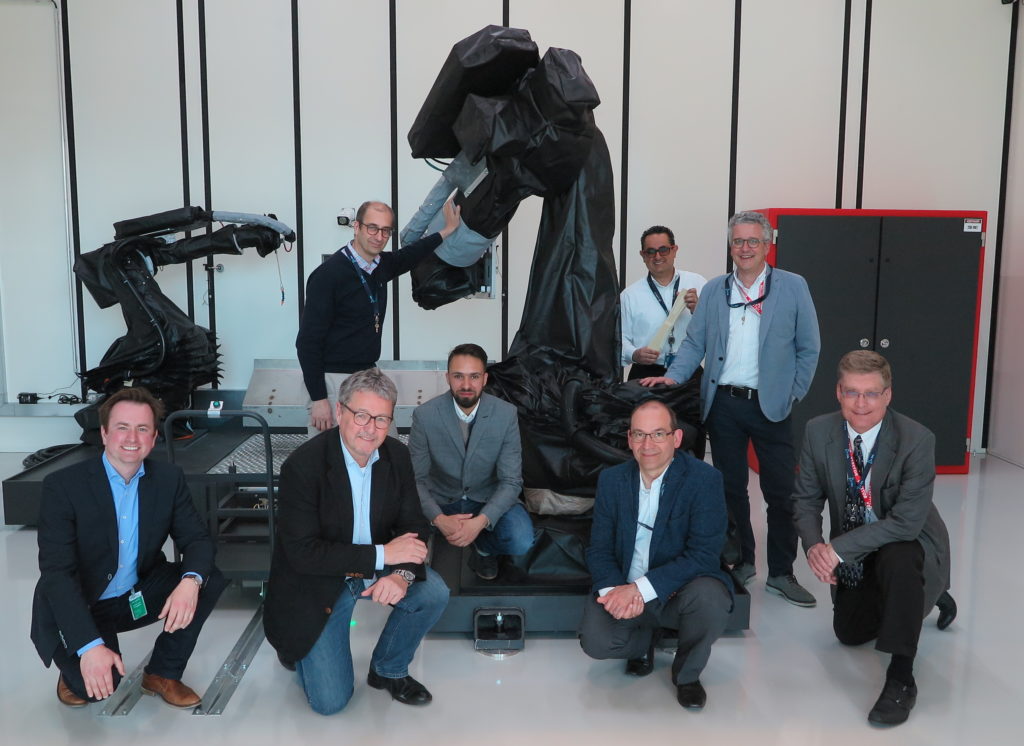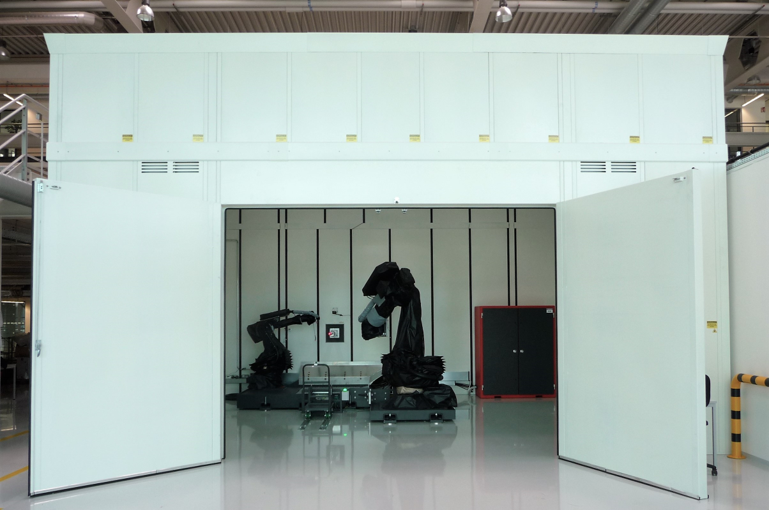Laser Peening Cell Now at ZAL in Hamburg
The installation of LSP Technology's Procudo® Laser Peening System at the ZAL TechCenter in Hamburg, Germany, became the cover story for the July 2018 issue of Metal Finishing News (MFN).
Posted: July 11, 2018
By:

The installation of LSP Technology’s Procudo® Laser Peening System at the ZAL TechCenter in Hamburg, Germany, became the cover story for the July 2018 issue of Metal Finishing News (MFN). The magazine highlighted the many applications of Laser Peening ZAL hopes to explore for the aerospace industry, collaborating with Airbus Industries, Lufthansa and LSP Technologies. Here is MFN’s original version in PDF format.
The aerospace industry has been driving innovation since the earliest days of flight. It takes a lot to defy gravity, to soar across oceans or eclipse the speed of sound. It takes research and foresight, confidence and cunning, a commitment to solving problems and anticipating risk. This mentality has defined aviation for generations, and some of humanity’s great advancements came from our quest to conquer the clouds.
Software, electronics, materials and medicine have all taken great leaps forward thanks to the dedicated work of aerospace engineers. There is no “good enough” in aerospace. There is no status quo. It’s an industry of advancement, improvement, and constant investigation as we seek to make aircraft safer and more efficient.
At the ZAL Center of Applied Aeronautical Research, this approach to innovation is laying the groundwork for the future of flight. Located in Hamburg, Germany, in the heart of one of the world’s largest aerospace clusters, the ZAL TechCenter is finding its wings as a next-generation aerospace research hub.
ZAL is a partnership that brings a diverse array of industry and research institution leaders together under one roof. Major shareholders and tenants include aviation heavyweights Airbus and Lufthansa Technik, innovation engines like the German Aerospace Center, a collection of esteemed Hamburg universities and promising start-up companies.
The result is a rich environment of open innovation, where industry titans team up with small and medium enterprise (SME) partners to accelerate the industrialization of new technologies. ZAL is structured around three Centers of Competence (CoC): Aircraft Manufacturing & MRO, Cabin & Systems, and Digitalization Technologies.
Each CoC is supported by a robust infrastructure of state-of-the-art equipment, giving researchers access to a variety of high-tech laboratories and test rigs. Virtual reality, additive manufacturing, and integrated robotics all play a prominent role as researchers collaborate on innovative enhancements for the next generation of aircraft. Now, with the installation of a high-repetition-rate Laser Peening System, ZAL adds a powerful new tool to their CoC Aircraft Manufacturing & MRO for forming and strengthening high-value aircraft parts.
Stronger Metals for Safer Aircraft
Aerospace engineering is a natural breeding ground for material enhancement innovations. Powered flight puts serious demands on parts with extremes of temperature, pressure, and stress. Can we make it stronger? Lighter? More durable? How do we push beyond the limitations of our materials?
Laser shock peening (LSP) has deep roots in aviation, with the first commercial LSP application on the Rockwell B-1 Lancer flown by the United States Air Force. In the 1990s, fan blades in the B-1 engines were failing due to cracks associated with foreign object damage. The Air Force discovered that laser peening around affected regions in the titanium blades would prevent crack propagation and significantly extend the blade life. Over the next few years, laser peening adoption blossomed as engine manufacturers Rolls Royce and GE Aviation applied LSP to high-value engine components. Applications have since expanded to include landing gear, bulkheads, wing lugs, and other critical aircraft structures.
Laser peening utilizes high-energy, short-duration laser pulses to produce deep compressive residual stress. The laser generates a high-pressure plasma burst on the part surface, and the rapid pressure rise sends a shockwave deep into the target material. The shockwave plastically deforms the metal, leaving a robust layer of compressive residual stress which improves fatigue life and damage tolerance by inhibiting crack growth.
Laser peening routinely generates compressive residual stress ten times deeper than shot peening can achieve. It’s a precision application, targeted at high-stress locations in components that are susceptible to cracking. Laser peening can be customized for almost any application, with a specialized recipe of laser parameters for each metal and loading scenario. This versatility means researchers have only scratched the surface of potential aerospace applications, and much of the LSP work at ZAL will be targeted at improving aerospace materials and components.
A High-Tech Approach to Evolved Manufacturing
Researchers at ZAL aim to expand the knowledge and understanding of laser peening by studying three specific areas of interest:
-
David Osman Busse powering up the new Procudo® Laser Peening System Fatigue and Damage Tolerance: Laser peening has shown significant value in both preventing crack initiation and in slowing the growth of existing cracks. This translates to longer-lasting components that are more resistant to damage. Given the many potential benefits of improved component durability, ZAL researchers will be looking closely at new strategies and applications to improve the fatigue and damage tolerance of various aeronautical structures. Laser peening provides a tool that allows engineers to design more efficient components and implement more cost-effective MRO activities. Breakthroughs in LSP enhancement at ZAL can extend the service life of flying fleets around the world and extend maintenance intervals for aircraft at all stages of the life cycle.
- Laser Peen Forming: Given the powerful stress enhancement imparted by laser peening, the process can be tailored to form or shape metal components via induced plastic strains. This precision forming method can deliver complex curvatures while simultaneously improving the fatigue resistance of the part. For the past ten years, laser peen forming has been utilized to form aerodynamic wing skins for the Boeing 747 aircraft. Now, researchers at ZAL will be looking at new strategies to use laser peening to form metallic aircraft components and correct distortions in manufactured parts. This will improve component integrity and reduce the volume of non-conforming parts that must be scrapped.
- Industrialization: A core focal point at ZAL is the concept of Industry 4.0. This emerging manufacturing philosophy integrates automation and digitalization to improve process efficiency at “smart” production facilities. Developing new laser peening applications will help ZAL researchers better understand modern industrialization concepts in the framework of Industry 4.0. Laser peening is a highly controlled process that can be finely tailored to optimize each individual laser pulse. Each processing sequence requires precise coordination between the laser and robot, and it produces a wealth of diagnostic data that can be evaluated in real time. By exploring new techniques for data-driven automated laser peening, ZAL researchers can translate these concepts into improved industrialization practices that enhance manufacturing capabilities for aerospace and beyond.
Production Equipment in a Research Environment

One of the key contributors working on laser peening at ZAL is systems engineer David Osman Busse. Dr. Busse came to ZAL with a background in aeronautical engineering and materials science and wrote his Ph.D. thesis on “Extending Fatigue Life of Aircraft Fuselage Structures by Using Laser Peening.”
Dr. Busse is well-versed in the industry benefits of laser peening and has great interest in seeing the technology implemented on a wider scale. “After almost four years academically researching and developing laser peening applications, I’m excited to be part of the LSP team at ZAL,” he said. “The synergy between academic research and applied technology is at the core of the ZAL mission, and this is manifested in the design of our new laser peening facility.”

The LSP facility at the ZAL TechCenter in Hamburg includes integrated modules for laser delivery, part processing, and systems control. At its heart is LSP Technologies’ diode-pumped Procudo® Laser Peening System, and processing takes place in a 260-cubic-meter peening cell. The setup gives researchers access to a true production system in a research environment, and Dr. Busse highlights the advanced capabilities this provides.
“Thanks to the size of the peening cell, the load capacity of the robot, and the high repetition rate of the laser system we are now able to efficiently process industrial scale components,” said Dr. Busse. “This allows us to develop real world applications for laser peening that go beyond academic study. These are innovations we expect to see flying on real aircraft in upcoming years.”
This comes back to the core mission of ZAL: accelerating new technologies toward large-scale industrialization. It’s not just a question of what laser peening can do for one part or one aircraft, it’s an evolved approach to manufacturing that should benefit the entire industry. “This is the dream for many R&T engineers like myself,” explains Dr. Busse. “We’re demonstrating what’s capable with laser peening right now, and our industry partners can carry the lessons learned at ZAL straight into their manufacturing and MRO facilities.”
Precision Forming Without Dies
Of particular interest to aerospace manufacturers are the capabilities of laser peen forming to produce complex curvatures. “Precise manufacturing of large components is a constant challenge in the aerospace sector,” explains Dr. Busse. “Structural components like fuselage panels and wing covers require very strict production tolerances, and laser peen forming offers a flexible and die-less technique for reducing variation in their manufacture.” Laser peen forming harnesses the power of controlled plastic strain to form and shape components. Engineers use analytical tools to model the stress distributions imparted by laser peening and predict the geometric response of the material. This allows accurate, scalable predictions that translate into a vast array of unique curvatures and shapes.
“Laser peening imparts very repeatable strain fields,” explains Dr. Busse. “The process can be reliably tailored to produce global deformations in large components and generate almost any shape.”
Laser peen forming offers significant advantages over conventional techniques like stretch forming in that it can produce almost any desired shape without the need for specialized dies. Laser peen forming can be used to shape thick panels of any metallic material, and it far exceeds the capabilities of shot peen forming due to the greater deformation imparted to the metal.
These capabilities allow manufacturers to form large components within precise tolerances, and to correct distortions in non-conforming parts. Meanwhile, laser peen formed parts retain the material benefits associated with compressive residual stress, making them less susceptible to cracking and damage.
Other forming methods can introduce tensile stresses into the part surface, which contribute to material degradation over time. Laser peen forming delivers precise component shapes while simultaneously enhancing the strength and durability of the part.
LSP research has already begun on the Procudo® Laser Peening System at the ZAL TechCenter. As operations ramp up, system time is being made available to manufacturers throughout Europe to develop new laser peening applications for improved cracking resistance, damage tolerance, and precision die-less forming. Lessons learned at ZAL will go a long way toward improving metal surface enhancement and manufacturing techniques for a wealth of industries around the world.
Contact LSP Technologies to learn more.
Interested in Seeing More?
Tell us about your application, material, or failure mechanism and we will have one of our experts reach out to you. Our extensive library of research and years of experience gives us a unique advantage to apply a finite element analysis to help diagnose the best application for your situation.


